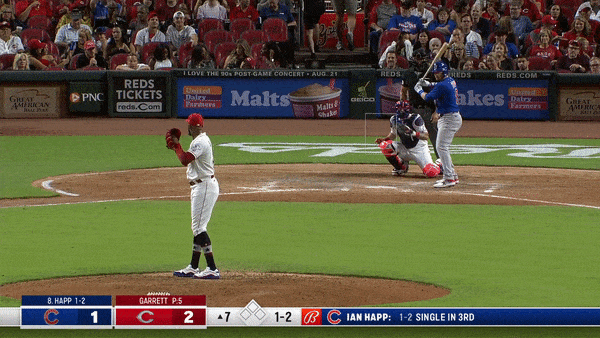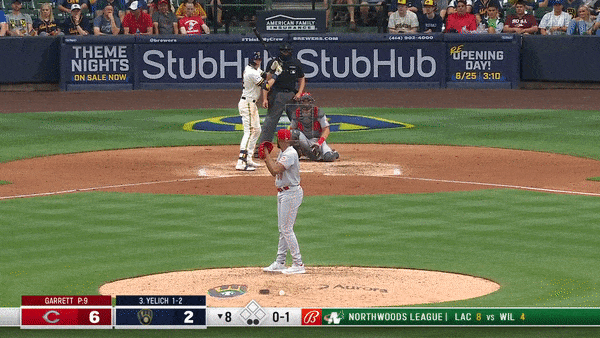Powering up the bullpen
Amir Garrett comes to the Royals in a trade. Just another guy who throws 95+ mph.
Transactions come at you fast.
After back-to-back days and several Tweets bemoaning the Royals’ lack of transaction action, they went and pulled quite the stealth move on Wednesday afternoon, acquiring left-handed reliever Amir Garrett from the fire-saling Reds in exchange for left-handed starter Mike Minor. It set off a chain reaction that culminated in the reunion of Zack Greinke and the Royals.
Minor, acquired as a free agent ahead of last year, led the staff with 158.2 innings. Certainly, we’re quite the distance from the days when Dayton Moore would hope that he could assemble a rotation that could throw 1,000 innings in a season. Even more so when you realize that the next three closest starters to Minor in innings pitched (Brad Keller, Kris Bubic and Brady Singer) all threw between 133 and 128 innings. Needing someone to fill the innings void left by Minor, the Royals turned to Greinke who has been a stalwart the last several seasons.
Minor, it should also be noted, was also the most valuable starter (and pitcher, for that matter) on the staff last year, at least according to fWAR. Certainly, a lot of that is accumulation. If you pitch enough innings and aren’t abjectly awful, that fWAR will climb a bit. Minor was good for 2.3 fWAR, just ahead of Scott Barlow’s 2.1 fWAR. Again, this is where Greinke will be expected to step in to fill the void. It’s quantity and quality.
Back to Garrett…He brings the relievers’ fastball/slider combo. The four-seamer clocks in around 95 mph with a little more horizontal break than the average fastball.
If he’s not working the corners with the pitch, it tends to hang a bit in the middle. He’s struggled with his control in the past—his walk rate was poor last year at 13.5 percent—so it’s understandable that he would groove a fastball from time to time trying to find a strike. Note where his catcher is set on a 1-2 pitch.
Garrett probably got away with that pitch because, in that situation, the count was in his favor. He isn’t always so fortunate. Opposing batters had a .291 average against his four-seamer with six of the nine home runs he allowed in 2021 coming against the pitch.
The slider…that’s Garrett’s bread and butter. It arrives about 10 mph slower than his fastball. According to Statcast, it features below average break, but it seems to feature a huge sweeping motion that carves up left-handed batters…
And righties as well…
Garrett’s Statcast peripherals weren’t that great last year. His hard-hit rate, average exit velocity and barrel percentage were all below the 20th percentile. As mentioned above, he struggled with control. However, his whiff rate of above 33 percent was elite. He’s going to have between 11 and 12 strikeouts per nine innings. The fastball has some hair. The slider shows some potential if he can locate off the four-seamer.
Garrett is also prone to surrendering the dinger. His career HR rate stands at 1.8 HR/9. I’m sure part of that has to do with pitching in that bandbox in Cincinnati. Regardless though, it’s been an issue. The home runs and walks are what has kept him from becoming a truly elite reliever. I understand that’s a “no kidding” kind of statement, but I make it only because Garrett has been able to tame both. Just not always at the same time. His best season was probably 2018 when he finished with a 3.6 BB/9 and 1.1 HR/9. But that was a year his strikeout rate was 10.1 SO/9, which was his lowest since he’s become a full-time reliever.
He joins a Royals bullpen populated with power arms.
That’s seven of what one would expect to be eight relievers who can pump straight gas. This is legitimately exciting.
It also dovetails nicely with a point made by J.J. Picollo: The Royals are helping their pitching staff overall by building out the back of their bullpen. With a stable of power arms at the ready for Mike Matheny, he can manage the workload of his starters…while not overtaxing his relievers. I expect a summer of near constant roster churn as the Royals are figuring ways to keep the bullpen healthy and ready. And by extension the starters. That will be particularly key early on for the starters with the shortened spring training.
The volatility of the reliever makes this move a solid gamble for the Royals. Garrett is eligible for arbitration for the second time in his career and is due $2.2 million according to the estimates published by MLB Trade Rumors. He will be a free agent after the 2023 season.
So the Royals flipped Minor and most of the money owed to him for a power reliever with some potential and two years of club control while filling Minor’s role with Greinke. Not a bad day of business for the Royals.
Prior to the Greinke announcement, yet almost immediately after the trade, the rumor mill (finally) started rumbling in earnest.


Interesting. Montas has a shade over four years of service time to his credit. That makes him, like Garrett, under club control for this year and next. According to MLB Trade Rumors, Montas is projected to earn $5.2 million next year. Naturally, the cost of acquiring a pitcher such as Montas would also require prospect capital. Figure at least two top 20 prospects (with the top half of the list mostly off limits) to make this trade happen.
We heard the Royals say the Greinke signing was in the works since before the lockout. Knowing this, if there are any teeth to the above rumor from Rosenthal, it would conceivably still be in play.
The Royals may not be done.









You Left off some off the better Garrett videos out there. He can bring the heat in more one way. Will be great to see emotion on display again.